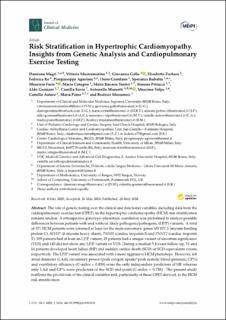Risk stratification in hypertrophic cardiomyopathy. Insights from genetic analysis and cardiopulmonary exercise testing
Magri, Damianio; Mastromarino, Vittoria; Gallo, Giovanna; Zachara, Elisabetta; Re, Federica; Piergiuseppe, Agostoni; Giordano, Dario; Rubattu, Speranza; Forte, Maurizio; Cotugno, Maria; Torrisi, Maria Rosaria; Petrucci, Simona; Germani, Aldo; Savio, Camilla; Maruotti, Antonello; Volpe, Massimo; Autore, Camillo; Piane, Maria; Musumeci, Beatrice
Journal article, Peer reviewed
Published version

Åpne
Permanent lenke
https://hdl.handle.net/11250/2766348Utgivelsesdato
2020Metadata
Vis full innførselSamlinger
- Department of Mathematics [939]
- Registrations from Cristin [9791]
Sammendrag
The role of genetic testing over the clinical and functional variables, including data from the cardiopulmonary exercise test (CPET), in the hypertrophic cardiomyopathy (HCM) risk stratification remains unclear. A retrospective genotype–phenotype correlation was performed to analyze possible differences between patients with and without likely pathogenic/pathogenic (LP/P) variants. A total of 371 HCM patients were screened at least for the main sarcomeric genes MYBPC3 (myosin binding protein C), MYH7 (β-myosin heavy chain), TNNI3 (cardiac troponin I) and TNNT2 (cardiac troponin T): 203 patients had at least an LP/P variant, 23 patients had a unique variant of uncertain significance (VUS) and 145 did not show any LP/P variant or VUS. During a median 5.4 years follow-up, 51 and 14 patients developed heart failure (HF) and sudden cardiac death (SCD) or SCD-equivalents events, respectively. The LP/P variant was associated with a more aggressive HCM phenotype. However, left atrial diameter (LAd), circulatory power (peak oxygen uptake*peak systolic blood pressure, CP%) and ventilatory efficiency (C-index = 0.839) were the only independent predictors of HF whereas only LAd and CP% were predictors of the SCD end-point (C-index = 0.738). The present study reaffirms the pivotal role of the clinical variables and, particularly of those CPET-derived, in the HCM risk stratification.
